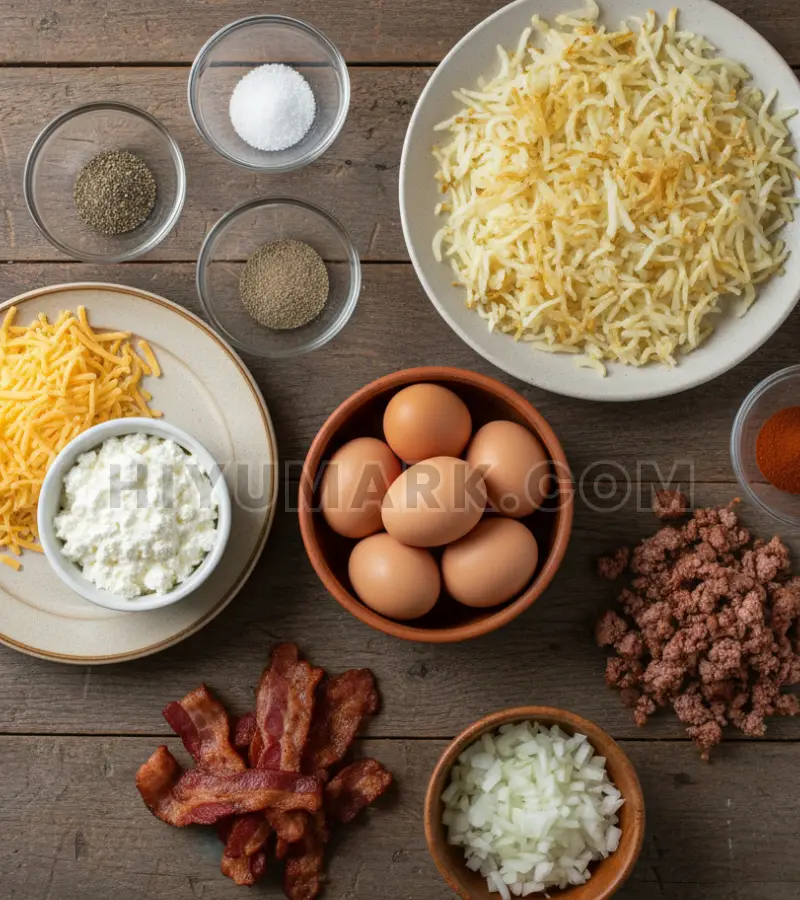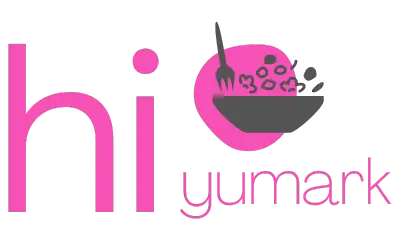Amish breakfast casserole recipe: a hearty, cheesy bake layered with potatoes, eggs, bacon or sausage, and plenty of flavor. It’s easy to make ahead, feeds a crowd, and works for both family mornings and special brunches.
Some breakfast dishes are simple; others feel like an event. This casserole belongs in the second category. It’s rich, filling, and made from everyday ingredients you already know – eggs, cheese, potatoes, and smoky meat.

What makes an Amish breakfast casserole special is the balance of textures. The potatoes form a soft but sturdy base, while the eggs and dairy bake into a fluffy layer that holds everything together. A mix of cheeses adds creaminess, and the bacon or sausage brings a smoky, savory bite.
This recipe has become a favorite for holidays, church gatherings, and weekend brunches. It can be prepared the night before, baked fresh in the morning, and served straight from the dish. In this guide, you’ll get the full recipe, helpful variations, storage tips, and answers to the most common questions people have about breakfast casseroles.
Looking for something filling to start the day? Try the ‘Amish Breakfast Recipes‘ – it’s made with simple ingredients and big flavor.
What Is an Amish Breakfast Casserole?
An Amish breakfast casserole is a layered dish of eggs, cheese, potatoes, and meat, baked until golden and set. Unlike lighter egg bakes, it is hearty and designed to feed a family or group with one pan. The recipe reflects Amish cooking traditions where simple, filling meals are made from pantry staples.
The casserole usually includes hash browns or cubed potatoes as the base, with a mixture of eggs, cottage cheese or shredded cheese, and cooked meats such as bacon or sausage. Onions or other vegetables are often added for extra flavor. The result is a rich, cheesy bake that holds together well when sliced.
This dish is popular for holidays, Sunday brunches, and potlucks, since it can be prepared in advance and baked fresh in the morning. It differs from many standard casseroles by being both denser and more flavorful, thanks to the combination of multiple cheeses and smoky meat.
Ingredients | What You’ll Need & Why
Every Amish breakfast casserole recipe starts with simple ingredients, but each one has a role in creating the rich, filling flavor that makes this dish stand out.

Eggs and Dairy
Eggs are the base that holds everything together. When whisked with milk or cream, they create a fluffy, custard-like texture. Cottage cheese or shredded cheese adds creaminess and keeps the casserole moist.
Potatoes
Hash browns are the most common choice since they bake evenly and form a soft but sturdy layer. Cubed potatoes work too if you want more bite. Some variations use bread cubes, but potatoes keep the dish closer to its Amish roots.
Meats
Most recipes use bacon, sausage, or a mix of both for smoky depth. The meat is cooked first so it blends into the casserole without releasing excess grease. Vegetarian versions simply skip the meat or replace it with plant-based alternatives.
Vegetables and Aromatics
Onions are almost always included for flavor. Some cooks also add bell peppers, mushrooms, or spinach to make the casserole heartier and more colorful.
Seasonings
Salt, black pepper, and sometimes dry mustard or paprika give the casserole balance. These simple spices ensure that the eggs and potatoes don’t taste bland.
Cheese Choices
Cheddar is the most common, but mozzarella, Swiss, or Colby can also be used. Mixing cheeses gives the casserole more depth and a gooey, stretchy texture.
Equipment
You’ll need a greased baking dish, usually 9×13 inches, plus mixing bowls and foil. A Dutch oven or cast-iron skillet can also work for baking and serving.
Step-by-Step Recipe: Basic Amish Breakfast Casserole
Making an Amish breakfast casserole is simple, but layering and timing are important. Here’s the full process.
Step 1: Prepare the Potatoes
If using frozen hash browns, thaw and pat them dry to prevent extra moisture. Fresh cubed potatoes should be parboiled until just tender. Spread the potatoes evenly across the bottom of a greased 9×13-inch baking dish.
Step 2: Cook the Meat and Vegetables
In a skillet, cook bacon or sausage until browned. Drain excess fat, leaving just enough for flavor. Add diced onions or other vegetables and sauté until soft and fragrant. This step builds the casserole’s savory base.
Step 3: Whisk the Egg Mixture
Crack eggs into a large bowl and whisk with milk or cream. Stir in cottage cheese or shredded cheese for richness. Season with salt, pepper, and dry mustard if using. This mixture binds all the layers.
Step 4: Layer the Casserole
Place the cooked meat and vegetables over the potatoes in the baking dish. Pour the egg mixture on top, making sure it spreads evenly. Sprinkle with more shredded cheese to create a golden, bubbly crust.
Step 5: Bake and Rest
Cover the dish with foil and bake at 350°F (175°C) for about 35 minutes. Remove the foil and bake another 15–20 minutes until the center is set and the top is lightly browned. Let the casserole rest for 10 minutes before slicing so it firms up.
Tip: To check doneness, insert a knife into the center. If it comes out clean, the casserole is ready.
Variations & Substitutions
One reason the Amish breakfast casserole recipe is so popular is its flexibility. You can adjust ingredients to match taste, dietary needs, or whatever is in your kitchen.
Meat-Free or Vegetarian
Skipping bacon or sausage doesn’t mean losing flavor. A vegetarian version works well with mushrooms, peppers, or spinach for bulk and savoriness. For smoky depth, add smoked paprika or a splash of liquid smoke.
Vegan Options
Egg replacers and plant-based cheeses can transform this into a vegan-friendly dish. Hash browns and vegetables keep the texture hearty while dairy alternatives hold the layers together.
Potato Choices
Hash browns are most common, but cubed potatoes create a chunkier bite. Some families even swap in bread cubes for a softer, quiche-like casserole, though potatoes keep it closer to Amish style.
Cheese Swaps
Cheddar is traditional, but Swiss, mozzarella, or Colby can bring different flavors. Mixing two cheeses gives a more complex taste and adds that gooey, stretchy finish on top.
Flavor Add-Ins
Extra vegetables such as onions, spinach, or jalapeños bring freshness and color. Herbs like parsley or thyme can also brighten the dish. For spice, a pinch of cayenne or hot sauce gives a gentle kick.
Regional Twists
In some versions, sausage takes center stage for a Southern touch, while others lean heavily on cottage cheese for creaminess. Barbecue enthusiasts sometimes add pulled pork for a smoky brunch spin.
How to Adjust Flavor & Texture?
Not every Amish breakfast casserole has to taste or feel the same. With a few small adjustments, you can make it creamier, crispier, lighter, or bolder.
Custardy or Firm
For a softer, custard-like casserole, add more milk or cream to the egg mixture. If you prefer a firmer texture that slices cleanly, reduce the liquid slightly and bake a bit longer.
Potato to Egg Balance
Using more potatoes gives the casserole a hearty, filling bite. Reducing potatoes and increasing eggs creates a lighter, more protein-rich version that feels closer to a frittata.
Salt and Spice Levels
If the casserole tastes too mild, add more seasoning before baking. Dry mustard, black pepper, or paprika can lift the flavor. For extra heat, stir in diced chilies or a pinch of cayenne.
Crispy Top vs Soft Inside
Leaving the casserole uncovered for the last 15 minutes allows the cheese topping to brown and crisp. If you prefer a softer surface, keep it covered for most of the baking time.
Moisture Control
To avoid soggy casserole, make sure vegetables are drained and hash browns are patted dry. On the other hand, if the dish feels too dry, add a splash of milk or broth before baking.
Make-Ahead, Storage, & Shelf Life
An Amish breakfast casserole recipe is perfect for planning ahead. You can prepare it the night before, store leftovers easily, and even freeze portions for later.
Make-Ahead Prep
Assemble the casserole fully, cover it tightly with foil, and refrigerate overnight. In the morning, bake as directed, adding a few extra minutes since it will be cold from the fridge.
Refrigerating Leftovers
Cooked casserole keeps well in the refrigerator for 3 to 4 days. Store it in airtight containers or wrap the dish tightly to maintain flavor and texture.
Freezing for Later
You can freeze the casserole either before or after baking. For unbaked, wrap tightly and freeze up to 2 months. For baked, cool completely, portion into squares, and freeze for quick breakfasts.
Reheating Tips
Warm in the oven at 325°F (160°C) until heated through. For single servings, use the microwave but cover with a damp paper towel to prevent drying.
Quick Reference Table
| Storage Method | Duration | Notes |
| Refrigerated (cooked) | 3–4 days | Store airtight, reheat gently |
| Frozen (unbaked) | Up to 2 months | Wrap tightly, bake from thawed |
| Frozen (baked) | Up to 2 months | Cool, portion, reheat in oven |
| Make-ahead (chilled) | Overnight | Assemble, refrigerate, bake next day |
8. Serving Suggestions & Pairings
An Amish breakfast casserole is hearty enough to serve on its own, but pairing it with the right sides makes the meal feel complete.

- Classic Breakfast Plate: Pair the casserole with fresh fruit, toast, or buttered rolls. The sweetness of fruit balances the savory richness of eggs, cheese, and potatoes.
- Brunch Style: Serve alongside muffins, pastries, or a light salad for a more varied spread. A glass of orange juice or coffee completes the brunch feel.
- With Meats and Sides: Smaller portions of the casserole can sit next to sausage links, ham slices, or crispy bacon. Add a side of hash browns if you want an extra potato boost.
- Garnishes and Toppings: Fresh herbs like parsley or chives add color and brightness. A spoonful of salsa or sour cream gives tang, while hot sauce adds spice for those who like heat.
- Leftover Ideas: Leftover squares can be tucked into breakfast sandwiches, reheated in a skillet for a crispy bottom, or packed in lunchboxes as a protein-filled meal.
Safety, Tips & Tricks
A well-made Amish breakfast casserole depends on a few small but important details. These tips help avoid common mistakes and keep the dish safe to eat.
Egg Safety
Always use fresh eggs and cook the casserole until the center is fully set. Undercooked eggs can cause food safety issues, so test doneness with a knife or thermometer.
Preventing Sogginess
Drain thawed hash browns and sauté vegetables before adding them. Extra moisture can make the casserole watery and affect texture.
Even Cooking
Spread the layers evenly and avoid piling ingredients too high. This ensures the casserole bakes consistently without a runny middle.
Greasing the Dish
Generously butter or oil the baking dish before layering. This prevents sticking and makes cleanup easier.
Resting Before Serving
Let the casserole rest for about 10 minutes after baking. The eggs firm up, making it easier to slice neat portions.
Troubleshooting Common Issues
Even with a solid Amish breakfast casserole recipe, small issues can come up. Here’s how to fix them so your dish turns out right every time.
Center Still Gooey: If the middle is undercooked, the casserole was too thick or the oven was too hot. Bake longer at a lower temperature and test with a knife to be sure it’s set.
Top Browning Too Quickly: Sometimes the cheese layer darkens before the center finishes cooking. Cover loosely with foil for the first part of baking, then uncover at the end to brown evenly.
Too Watery: Extra liquid from thawed potatoes or vegetables can cause sogginess. Always drain well and sauté vegetables before adding them to the dish.
Too Dry: If the casserole feels dry, it may have overbaked. Next time, add a splash more milk to the egg mixture and reduce baking time slightly.
Ingredients Separating: When the egg mixture pools at the bottom, it usually means the ingredients weren’t layered evenly. Spread the potatoes, meat, and vegetables in balanced layers before pouring in the eggs.
Frequently Asked Questions
Can I Make Amish Breakfast Casserole Ahead of Time?
Yes. Assemble it the night before, cover tightly, and refrigerate. Bake the next morning, adding a few extra minutes since it starts cold.
Can I Freeze This Casserole?
You can freeze it either before or after baking. Wrap tightly and freeze up to 2 months. Thaw overnight in the fridge and reheat in the oven for best results.
What Kind of Potatoes Work Best?
Frozen hash browns are the easiest and most reliable. Cubed potatoes also work if they are parboiled first. Fresh shredded potatoes should be squeezed dry to avoid excess moisture.
Can I Use Sausage Instead of Bacon?
Absolutely. Sausage, ham, or even a mix of meats work well. Just cook them fully before layering into the casserole.
How Do I Reheat Leftovers Without Drying Them Out?
Reheat covered in the oven at 325°F (160°C). For single portions, microwave with a damp paper towel on top to keep moisture in.
What Size Baking Dish Should I Use?
A standard 9×13-inch dish is perfect for this recipe. For half batches, use an 8×8-inch or similar pan.
Can I Make It Gluten-Free or Dairy-Free?
Yes. The casserole is naturally gluten-free if you avoid bread bases. For dairy-free, use plant-based cheese and milk substitutes.
Why This Recipe Stands Out
This Amish breakfast casserole isn’t just filling – it’s a dish that blends tradition, comfort, and flexibility in one pan. Here’s what makes it special.
Rooted in Tradition
The recipe reflects Amish and Pennsylvania Dutch cooking, where simple farm ingredients are turned into rich, satisfying meals. It carries that same homemade comfort into modern kitchens.
Balanced Flavor
Eggs, potatoes, cheese, and smoky meat come together in layers that are both hearty and flavorful. The balance of creamy and savory makes it more memorable than standard egg bakes.
Flexible for Every Cook
It works with bacon, sausage, or even no meat at all. You can swap cheeses, add vegetables, or adapt it for vegetarian and gluten-free diets without losing the character of the dish.
Perfect for Gatherings
This casserole is made for sharing. It feeds a crowd, holds well on a buffet table, and reheats beautifully. Whether it’s Christmas morning or a casual brunch, it always fits in.
Conclusion
A warm slice of Amish breakfast casserole brings comfort to any table. With its golden top, creamy layers, and hearty flavor, it turns simple ingredients into something special.
This dish is more than a breakfast – it’s a recipe that adapts to your family’s taste, reheats well, and feels right for both everyday mornings and holiday gatherings.
Try it once, and you’ll see why it has earned a place in Amish kitchens for generations. Chances are, it may become one of those recipes your own family asks for again and again.
Read related recipes:
Amish Breakfast Casserole Recipe
Course: BreakfastCuisine: AmericanDifficulty: Medium8
servings15
minutes50
minutes420
kcal1
hour5
minutesA comforting, hearty brunch bake layered with potatoes, eggs, cheese, and smoky meat. Easy to assemble ahead and always crowd-pleasing.
Ingredients
4 cups frozen hash browns (thawed & drained)
6 large eggs
1 cup milk or cream
1 cup cottage cheese
2 cups shredded cheddar cheese
1 cup shredded Swiss (or mix cheese)
8 oz bacon or sausage, cooked & crumbled
1 small onion, diced
Salt & pepper to taste
Optional: dry mustard, smoked paprika
Directions
- Preheat oven to 350°F (175°C). Grease a 9×13 baking dish.
- Spread potatoes evenly across the bottom.
- Cook meat and onion; drain excess fat.
- Whisk eggs, milk, cottage cheese, salt, pepper, and spices.
- Layer meat & onion over potatoes. Pour egg mixture on top.
- Sprinkle with remaining cheese. Cover with foil.
- Bake for 35 minutes; remove foil and bake another 15 minutes.
- Let rest 10 minutes before slicing.
Recipe Video
Notes
- Make sure hash browns are well drained so casserole doesn’t get soggy. Let it rest before cutting so it holds its shape and slices cleanly.
